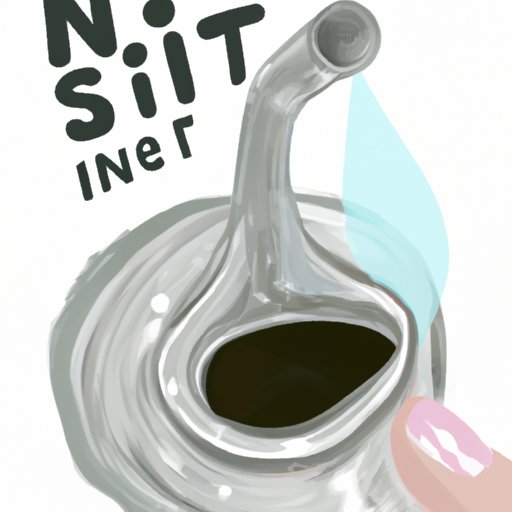I. Introduction
If you’ve ever experienced a blocked nose or congestion, then you know the importance of sinus drainage. Sinus drainage is the process of clearing the mucus and other debris present in the sinuses. Keeping the sinuses clear is essential for healthy breathing, and it can also help reduce the risk of sinus infections. In this article, we will explore various methods for draining your sinuses, including how to use a neti pot, steam inhalation, nasal spray, acupressure points, hydration tips, and lifestyle changes you can make to improve your sinus health.
II. How to Use a Neti Pot
One of the most popular and effective ways to drain your sinuses is by using a neti pot. A neti pot is a container specifically designed for flushing the sinuses with saline water. It helps remove excess mucus, allergens, and other irritants that may cause nasal congestion.
To use a neti pot, you will need to mix a saline solution by dissolving 1/4 teaspoon of non-iodized salt in 8 ounces of warm sterile water. The water should be warm enough to create a comfortable sensation when poured into the nostrils. Follow these steps to use a neti pot:
- Fill the neti pot with the saline solution
- Lean over a sink and tilt your head to one side
- Place the spout of the neti pot in the upper nostril and pour the saline solution through the nostril. The solution will flow out through the lower nostril. Keep breathing through your mouth while doing this.
- Repeat the process on the other nostril.
Be sure to clean your neti pot thoroughly after each use to avoid contamination. Only use distilled or sterile water to avoid the risk of infection, particularly if you live in areas where tap water is not safe to drink.
III. Steam Inhalation
Steam inhalation can help open up your sinuses and reduce inflammation caused by congestion. You can use essential oils or herbs to enhance the benefits of steam inhalation. Eucalyptus oil is known to be particularly effective for sinus drainage.
To do steam inhalation, boil a pot of water and add a few drops of essential oil or herbs. Once you’ve turned off the heat, cover your head with a towel and inhale the steam for 5-10 minutes. Be careful not to expose your face to excessive heat, and avoid touching hot surfaces to prevent burns.
IV. Nasal Spray
Nasal sprays, particularly saline nasal sprays, can help moisturize the sinuses and reduce inflammation. They work by increasing the flow of mucus and helping flush out irritants, allergens, and bacteria that may be present in the sinuses.
To use a nasal spray, follow these steps:
- Blow your nose to get rid of any excess mucus.
- Shake the bottle and remove the cap.
- Tilt your head slightly forward and insert the tip of the bottle into one nostril. Keep the other nostril closed.
- Breathe in slowly while squeezing the bottle to release the spray.
- Repeat the process on the other nostril.
Be sure to follow the instructions on the bottle and avoid overusing nasal sprays, as it can cause dependency and worsen congestion in the long run.
V. Acupressure Points
Acupressure points can help improve blood flow and drainage in the sinuses, helping to reduce congestion. Pressing on certain points can also help relieve pain, headaches, and other symptoms associated with sinus problems.
To apply pressure to the acupressure points, use your index and middle finger to press and massage the points in a circular motion. You can also use a small amount of pressure with your thumb. Press each point for 3-5 minutes, several times per day. These are some of the most common acupressure points:
- The bridge of the nose at the base of the eyebrows
- The point below the cheekbones, right in line with the pupils
- The point at the bottom of the nostrils, on the top lip
VI. Hydration Tips
Staying hydrated can help flush out excess mucus and reduce inflammation in the sinuses. Drinking plenty of water and other fluids can help thin out the mucus, making it easier to drain. In addition, avoiding caffeine and alcohol, which can cause dehydration, can help improve your sinuses’ health.
Other drinks that are beneficial for hydration include tea, fruit juices, and broths. Eating fruits and vegetables with high water content, such as watermelon and cucumber, can also help keep you hydrated.
VII. Lifestyle Changes
Making certain lifestyle changes can also help improve your sinus health. Quitting smoking can help reduce sinus infections and other respiratory illnesses. Likewise, avoiding allergens, such as pollen and dust, can reduce inflammation and irritation in the sinuses.
Eating a healthy diet that includes plenty of fruits, vegetables, and lean protein can help boost your immune system and reduce sinus infections. Reducing stress through relaxation techniques, such as meditation and yoga, can also help improve your overall health and reduce inflammation.
VIII. Conclusion
Taking care of your sinus health is essential for staying healthy and breathing easily. By using the methods outlined in this article, such as using a neti pot, inhaling steam, using nasal sprays, applying acupressure, staying hydrated, and making lifestyle changes, you can improve your sinuses’ health and prevent future infections.
Remember to always follow the instructions carefully and to seek medical attention if your symptoms persist or worsen over time. Consult your doctor if you have any underlying health conditions or concerns before trying any of these methods.
